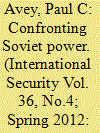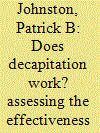|
|
|
Sort Order |
|
|
|
Items / Page
|
|
|
|
|
|
|
| Srl | Item |
| 1 |
ID:
112469


|
|
|
|
|
| Publication |
2012.
|
| Summary/Abstract |
Although the issue of knowledge diffusion has been at the heart of nonproliferation research and policies, no study in the political science field has thus far systematically identified the mechanisms that allow the acquisition and efficient use of specialized knowledge related to bioweapons. This analytical gap has led to the commonly held belief that bioweapons knowledge is easily transferable. Studies of past weapons programs, including the former U.S. and Soviet bioweapons programs, show that gathering the relevant information and expertise required to produce a weapon is not sufficient to guarantee success. The success of a bioweapons program is dependent on intangible factors, such as work organization, program management, structural organization, and social environment, which can enhance the advancement of a program or create obstacles to progress. When assessed within smaller state and terrorist bioweapons programs, such as those of South Africa and the terrorist group Aum Shinrikyo, these intangible factors produce the same constraining effects as in larger programs. More important, intangible factors have a significant effect on covert programs, because clandestinity imposes greater restrictions on knowledge diffusion. By taking into account these intangible factors, analysts and policymakers can improve their threat assessments and develop more effective nonproliferation and counterproliferation policies.
|
|
|
|
|
|
|
|
|
|
|
|
|
|
|
|
| 2 |
ID:
112471


|
|
|
|
|
| Publication |
2012.
|
| Summary/Abstract |
Many self-identified realist, liberal, and constructivist scholars contend that ideology played a critical role in generating and shaping the United States' decision to confront the Soviet Union in the early Cold War. A close look at the history reveals that these ideological arguments fail to explain key aspects of U.S. policy. Contrary to ideological explanations, the United States initially sought to cooperate with the Soviet Union, did not initially pressure communist groups outside the Soviet orbit, and later sought to engage communist groups that promised to undermine Soviet power. The U.S. decision to confront the Soviets stemmed instead from the distribution of power. U.S. policy shifted toward a confrontational approach as the balance of power in Eurasia tilted in favor of the Soviet Union. In addition, U.S. leaders tended to think and act in a manner consistent with balance of power logic. The primacy of power over ideology in U.S. policymaking-given the strong liberal tradition in the United States and the large differences between U.S. and Soviet ideology-suggests that relative power concerns are the most important factors in generating and shaping confrontational foreign policies.
|
|
|
|
|
|
|
|
|
|
|
|
|
|
|
|
| 3 |
ID:
112468


|
|
|
|
|
| Publication |
2012.
|
| Summary/Abstract |
Is killing or capturing insurgent leaders an effective tactic? Previous research on interstate war and counterterrorism has suggested that targeting enemy leaders does not work. Most studies of the efficacy of leadership decapitation, however, have relied on unsystematic evidence and poor research design. An analysis based on fresh evidence and a new research design indicates the opposite relationship and yields four key findings. First, campaigns are more likely to end quickly when counterinsurgents successfully target enemy leaders. Second, counterinsurgents who capture or kill insurgent leaders are significantly more likely to defeat insurgencies than those who fail to capture or kill such leaders. Third, the intensity of a conflict is likelier to decrease following the successful removal of an enemy leader than it is after a failed attempt. Fourth, insurgent attacks are more likely to decrease after successful leadership decapitations than after failed attempts. Additional analysis suggests that these findings are attributable to successful leadership decapitation, and that the relationship between decapitation and campaign success holds across different types of insurgencies.
|
|
|
|
|
|
|
|
|
|
|
|
|
|
|
|
| 4 |
ID:
112467


|
|
|
|
|
| Publication |
2012.
|
| Summary/Abstract |
Several states, including Israel and the United States, have put decapitation tactics, which seek to kill or capture leaders of terrorist organizations, at the forefront of their counterterrorism efforts. The vast majority of scholarly work on decapitation suggests, however, that leadership decapitation is ineffective at best and counterproductive at worst. Contrary to this conventional wisdom, leadership decapitation significantly increases the mortality rate of terrorist groups, although the results indicate that the effect of decapitation decreases with the age of the group, even to a point where it may have no effect at all. This finding helps to explain the previously perplexing mixed record of decapitation effectiveness. Terrorist groups are especially susceptible to leadership decapitation because their organizational characteristics (they are violent, clandestine, and values based) amplify the difficulties of leadership succession. Additionally, in contrast to the conventional wisdom regarding the durability of terrorist groups, politically relevant terrorist groups (defined as those with at least four attacks including one attack resulting in a fatality) endure significantly longer than previously believed.
|
|
|
|
|
|
|
|
|
|
|
|
|
|
|
|
| 5 |
ID:
112470


|
|
|
|
|
| Publication |
2012.
|
| Summary/Abstract |
World War I is generally viewed by both advocates and critics of commercial liberal theory as the quintessential example of a failure of economic integration to maintain peace. Yet this consensus relies on both methodologically flawed inference and an incomplete accounting of the antecedents to the war. Crucially, World War I began in a weakly integrated portion of Europe with which highly integrated powers were entangled through the alliance system. Crises among the highly interdependent European powers in the decades leading up to the war were generally resolved without bloodshed. Among the less interdependent powers in Eastern Europe, however, crises regularly escalated to militarized violence. Moreover, the crises leading to the war created increased incentives for the integrated powers to strengthen commitments to their less interdependent partners. In attempting to make these alliances more credible, Western powers shifted foreign policy discretion to the very states that lacked strong economic disincentives to fight. Had globalization pervaded Eastern Europe, or if the rest of Europe had been less locked into events in the east, Europe might have avoided a "Great War."
|
|
|
|
|
|
|
|
|
|
|
|
|
|
|
|
|
|
|
|
|